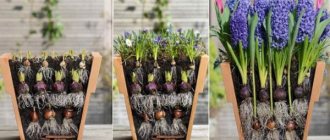Autumn is a very important time for gardeners, because many types and varieties of garden flowers are bred by planting them during this period, limited to specific months, for example, September-October. Timely planting of bulbous flowers in the fall is especially important. So the topic of our text is definitely related to the specific optimal timing of planting them in open ground, with the choice of location, with the correct preparation of the soil for planting, with the selection, again, of the correct fertilizers for their vegetation in the autumn-winter period and successful rich spring flowering.
Floriculture practice shows that the best time for autumn planting of bulbous crops is precisely in September and October, taking into account the specific climatic zone. And we plant winter vegetable varieties of bulbous garden crops: garlic, onions in the fall, as required by the agricultural technology of their cultivation.
- Place to plant bulbous flowers before winter
- What kind of soil do bulbous flowers need in the fall?
- Autumn fertilizers for bulbous flowers
- Preparing flower bulbs for planting before winter
- When to plant bulbous flowers in the fall?
- Planting depth of bulbous flowers
- How to plant bulbous flowers in the fall?
- Shelter and care for bulbous plants in autumn
A large number of bulbous ornamental plants are primroses - a bright decoration of the spring flower garden in our gardens and front gardens. These include the diverse family of hyacinths, snowdrops, crocuses, daffodils, and tulips; if they are late with their timely planting in the prescribed autumn months, we will be left without a flower primrose festival, which we do not want at all. Previously, we already discussed what flowers can be planted in the fall, but today we’ll talk about planting bulbous flowers before winter and the nuances associated with this.
Place to plant bulbous flowers before winter
For flower crops of this group, earlier flowering periods are preferable to a sunny, windy place, and later flowering bulbous plants will have time to develop and delight with long-term abundant flowering even in an area with partial sunny days. So this fact must be taken into account when organizing a flower garden or flower bed.
In addition, given the impossibility of growing bulbs in conditions of stagnant moisture, care should be taken about drainage measures. for example, create a slight slope in the flower bed to drain melt water in the spring.
What kind of soil do bulbous flowers need in the fall?
The planting soil should be sufficiently loose, fertile, with normal drainage capabilities. Excessive soil density will create conditions for waterlogging and rotting of planting material for bulbous crops.
If there is no choice, you need to design a planting bed. Initially, dig a hole of the required size, the bottom of which is laid with a 4-5 cm drainage layer of a mixture of crushed stone, gravel and coarse sand. Place planting soil on top of the created drainage cushion.
Autumn fertilizers for bulbous flowers
Before applying fertilizer, the soil should be cleared of weeds. Their individual species with deep roots, for example, bindweed, dandelion, thistle, should be removed with a shovel with the root.
It is more advisable to use complex mineral fertilizers to fertilize bulbous plants. From the organic line of fertilizers, you can use ripe compost in small quantities.
The introduction of manure can threaten the plants with infection with fungal diseases and their spread throughout the entire planting, and will also become a bait for earthworms and moles. It is important to apply fertilizers during digging, the depth of which should be at least 30-35 centimeters.
Preparing the bulbs and soil
Hyacinth bulbs
We have decided on the types of flowers, now let’s move on to preparing the bulbs for planting in the ground.
We carefully select planting bulbs. Damaged, with spots, soft and darkened, we throw it away without regret. Only from relatively large, even and necessarily hard bulbs will a strong and healthy plant grow. The bulb should not have a soft neck or bottom, overgrown roots, or a heavily sprouted stem. Good planting material is already half the success. Immediately before planting, you can soak the bulbs for half an hour in the “Maxim” preparation to prevent rot.
Bulbous plants are planted in an area that is sufficiently lit and well protected from the wind. They love loose and permeable soil, so to avoid bulb diseases, you need to avoid stagnant water. Remove all weeds by the roots. Dig up the area (about the size of a spade). Apply fertilizer. It is better to use mineral fertilizers, compost or wood ash (manure cannot be used as a fertilizer for bulbous plants). There should be little fertilizer, since bulbous plants do not like excess.
If the soil on the site is too dense or clayey, then it is better to make drainage from sand about 5 cm (you can also use crushed stone or gravel). Bulbous flowers can be planted under tree branches because when they begin to bloom, there will be no leaves on the trees yet.
Preparing flower bulbs for planting before winter
In order to grow plants that are impeccable in all respects, when purchasing planting material, you should carefully select the bulbs for quality by carefully examining them.
A high-quality bulb should be of normal size, without external damage - both mechanical and painful signs (mold and putrefaction).
Even one unhealthy bulb can become a source of general infection for the entire bulbous flower garden. 30 minutes before planting in open ground, the bulbs should be kept in a weak solution of potassium permanganate or foundation and treated with a specialized growth stimulator.
Small and large brothers
Let's start with small-bulbed flowers, which include snowdrops, scylla, crocuses and muscari. The time for planting them is in early September, but in the southern regions this time extends until October. These plants are not large in size, so the greatest aesthetic effect is achieved by mass planting of flowers. But individually, any of these species will delight you no less.
The bulbs of lilies, tulips and daffodils, which are planted later than snowdrops and scylla - at the end of September and until the end of October, are much larger.
The main condition for planting any bulbous flowers is to have time to plant them at such a time that the bulb can take root in the ground and acquire a good root system, but does not germinate before the first frost occurs.
It is not necessary to dig up fall flower bulbs after they have finished blooming. Next year they will definitely bloom again. You just need to take into account that varietal traits will be lost every year, so updating the colors will be necessary.
When to plant bulbous flowers in the fall?
In central Russia, bulbous flower crops are planted from mid-September to mid-October. The soil temperature is desirable up to +10 C, and this natural condition puts forward the requirement to allow the rooted bulbs to begin the correct development of the root system within 10 days so that the weather does not interfere with this process by a sharp drop in temperature.
Premature planting of bulbs in the fall will provoke premature shoots in the spring, which may die from spring frosts. A delay in planting can result in poor rooting or even freezing of the planting material. In the southern regions, the planting period for bulbous plants can be slightly extended, depending on the weather conditions.
Advice from experienced gardeners
Gardeners who are interested in growing and breeding bulbous flowers give some interesting tips that will help novice gardeners successfully grow these crops.
- A very convenient way to plant bulbs is in a small plastic basket. Its bottom is covered with a layer of nutrient substrate, the bulbs are placed and buried to the required depth. There are many advantages:
- there is no loss of bulbs;
- convenient to dig and plant;
- planting material is reliably protected from rodents and other pests.
- Do not throw away the bulb packaging after planting. If you like the variety of a particular plant, you can easily purchase additional planting material instead of waiting for the babies to appear.
The method of placing in a basket has become very popular and is considered one of the main methods of planting bulbous flowers.
Planting bulbs in autumn in nets and containers: video
Planting depth of bulbous flowers
This is a very important and responsible measure, which is associated with the survival and successful development of bulbous flowers. Typically, the planting depth of bulbs is calculated by multiplying their height three times. Bulbs of smaller crops: crocuses, muscari, snowdrops - a planting depth of 5 to 10 centimeters is sufficient. Bulbs of tulips, lilies, and imperial hazel grouse require planting at a depth of 15-20 centimeters.
Taking into account the density of the planting soil, the depth of planting bulbs may vary. On heavy soil it can be reduced by 2-3 centimeters, and on light soil it can be increased by the same 2-3 centimeters. The spacing between bulbs when planting is also related to their size. The distance between the bulbs in a line is 8-10 centimeters, and between the rows - 20-25 centimeters.
How to plant bulbs correctly
All bulbous flowers are planted according to the same principles, so below are general instructions for planting them.
Preparing the seat
Bulbous plants love loose, well-drained soils. In heavy soils, there is stagnation of water, which can be detrimental to the bulbs when the snow melts - they will simply rot. In too light soils, the bulbs may become self-burdened, and as a result, flowering may be delayed or not occur at all.
The next requirement for soils is neutral acidity; slightly acidic substrates are also allowed. Therefore, if the soil is strongly acidified, it is limed in advance, and if the soil is alkaline, it is acidified.
The fertility of the substrate is ensured by adding compost and a small amount of phosphorus-potassium mineral fertilizers. It is recommended to prepare the planting site for bulbous plants 2 months before the start of work so that the soil has time to settle.
Preparing the bulbs
Pre-planting treatment of the material will allow you to avoid many problems associated with the harmful activities of insects and pathogens.
- Firstly, the bulbs themselves, especially those purchased from untested places, can be infected, and all the infections will spread to the garden soil, after which they will spread throughout the entire area.
- Secondly, there may be vicious pests in the garden soil that will gladly attack the planted flowers during the period of active activity. Therefore, various types of processing of planting material are used, which do not cause any harm to it, but increase resistance to infection by pests and diseases.
To prevent fungal diseases, bulbs are immersed in a solution of fungicide or potassium permanganate for an average of half an hour. To prevent pests, they are soaked in water at a temperature of 400C for 5 minutes.
Planting bulbs
Before planting, determine how deep the bulbs need to be placed. Here they use one simple rule: the height of the bulb is multiplied by 3. The result obtained is the optimal depth. If the soil is light, the bulb is deepened by another 1...2 cm, and if it is heavy, on the contrary, it is raised by the same amount.
At the calculated depth, the top layer of soil is removed, the bottom of the planting site can be covered with a layer of fine sand of 2...3 cm. This will protect the bulbs from pests penetrating from below through the bottom.
The distances between adjacent bulbs depend on their size. For example, large specimens must be placed at a distance from each other of at least 8...10 cm, small ones - 5 cm.
The children are placed in a separate bed for rearing.
Watering and mulching
After all the bulbs are in place, the soil is well watered and mulched if necessary. It occurs when the material is not planted in a timely manner: bulbs that have started to grow or are planted in cold soil are covered with a layer of mulch up to 10 cm.
Planting bulbous flowers in autumn: video
Shelter and care for bulbous plants in autumn
This measure is especially important in regions with harsh and snowless winters, where it becomes necessary to cover the bulbous flower garden in order to preserve the bulbs. For such a protective covering, you can use dry leaves, straw, spruce paws, or multi-layer folded non-woven material.
You should also take into account the force of the wind tearing off any covering - place beams or other available material on top. It is necessary to remove the cover as soon as the snow melts, so as not to damage the emerging seedlings of primroses.
All that remains is to clearly determine the types of bulbs you prefer for planting, purchase them in advance, choose the right planting location and prepare the soil by digging and fertilizing with the right fertilizer. Carefully plant the bulbs, protecting them from the coming harsh winter, so that in the spring a carnival of primroses will take place on your site: daffodils, false daffodils, tulips, hyacinths, muscari - also known as mouse hyacinth or viper onion, multi-colored crocuses. Proper subsequent care will allow a flower bed with bulbous primroses to delight you for several years without replanting.
In addition, almost all primroses are very suitable for cutting. Even muscari and snowdrops can be cut for miniature bouquets, not to mention daffodils and tulips. With these beautiful flowers, spring with their fresh aroma comes to our cozy homes, improving our mood and giving us a smile of tenderness.
Galanthus
Behind the elegant name galanthus lies the familiar snowdrop - the first “ambassador” of spring after the cold winter months. Its flowering begins in February-March.
We are used to finding snowdrops on forest edges, but delicate flowers can also decorate a flower bed in your garden.
It is worth considering that this culture does not like frequent transplants, so it is advisable to plant the bulbs once in a permanent place.
Planting technique: Galanthus planting dates are September-October. It is advisable to plant 5-6 bulbs in one place. They are deepened by about 5 cm.
Read more about how to replant galanthus in our material:
- When and how to replant galanthus?
You don't have to wait until autumn to replant snowdrops!











